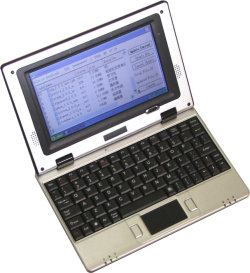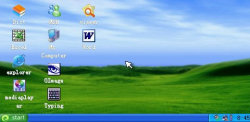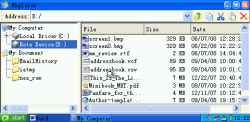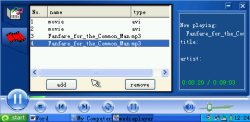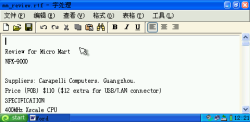Author: Phil Thane
The wave of cheap netbooks, mini laptops, or ultra-mobile PCs has crested with the cheapest yet, the NPX-9000 from Carapelli. Though it was announced in July with great fanfare at a price of £65 (or $110), it has yet to appear on the vendor’s Web site. But we got our hands on one of the first units to escape from the factory and put it through its paces. We found that you get what you pay for — if that.
The low price for the NPX-9000 is a bit of a tease. That’s actually the price for each of 100 units delivered to a plane or ship in China. If you buy it from an importer you’ll see the added effect of shipping costs, import duties, and, in the EU, value-added tax (VAT), so the retail price might be almost double what was announced last summer. However, Carapelli says no one in Europe or North America is currently selling the NPX-9000; retailers are waiting for the Windows XP-equipped TNX-9500, at which time they’ll sell both, Carapelli says.
There are several identical-looking mini laptops around at the moment, such as one from Maplin in the UK and one from Impluse in the US. They look the same because they are built using the same chassis, but that’s where the similarities end. The NPX-9000 has a slower processor (Marvel Xscale running at 400MHz), less RAM (128MB), less storage (1GB flash), and a lower screen resolution (480×324 pixels on a seven-inch screen) than the other models. The 80-key keyboard is about 80% of full-size. It doesn’t have built-in networking or Wi-Fi either; the review model came with a USB Ethernet adapter, though the vendor says a built-in wireless adapter will be available in future models. Attempts to use a third-party Wi-Fi adapter failed because users can’t get into a setup screen.
Other hardware includes a built-in mic and speakers; VGA port; four USB ports (three normal and one mini); mic, headphone, and line sockets; and an SD card slot.
Carapelli develops its own Linux OS and software based on the 2.4 kernel for ARM processors and various free software projects. The splash screen calls it Highne 2008, but no other details have been released. The company says it has no plans to open source its software; providing it does not modify any GPLed code and just uses it as it stands, it does not have to release its work.
The system is locked down tight. You can browse around the filesystem using the Web browser, but there is no terminal emulator to run commands, nor a “Run Command” GUI. There is a software update system that downloads and install updates, but it doesn’t allow you to install any new applications. There is no way of logging in without a graphical user interface and no BIOS setting you can adjust to change the boot process, so short of flashing the ROM chip there’s no way you can change the OS or add software.
The OS has been customized to look very much like a cut-down version of Windows XP. Go to My Computer and you get a C: drive and My Documents. Plug in a USB stick and it becomes the D: drive. For users who want a simple appliance that’s probably ideal, but it won’t endear it to Linux aficionados. On the review machine the XP look and feel even extends to using Microsoft icons and the XP welcome chime, something Carapelli has pledged to fix before release.
Using a screen this small brings some limitations. Font rendering is not great, and most Web sites don’t fit the browser. Other limitations are irritating but you can work round them. For example, you cannot open two instances of My Computer to drag and drop files between (there wouldn’t be space to see them if you could), so you have to copy a file, then move to the new directory and paste it.
The review model’s optional USB Ethernet adapter uses DHCP by default, though you can specify a fixed address if you want. When you connect to a router the system goes online so you can browse the Web, but you cannot browse the local network.
A device like this relies heavily on its Web browser, which means the NPX-9000 struggles. The browser appears to be based on Konqueror, which is a very capable browser, but it has been hobbled. Whether this has involved modifying the source code and thus contravening the GPL I am not qualified to judge; it may be a standard OESF version or some other project of which I am unaware. The browser is usable for casual surfing, but it doesn’t allow you save pages, copy and paste text from Web sites into the word processor, or even bookmark them, making it useless for research.
The NPX-9000 is not much use for entertainment either; Flash is supported only up to version 6, so no YouTube. There is a simple media player for MP3 and AVI files. The screen does a reasonable job displaying widescreen (but low-res) video. The speakers are tiny and tinny, but sound quality via headphones is surprisingly good.
The bundled office applications, a simple word processor and spreadsheet, are OK in themselves, but compatibility with better-known office suites is very limited. The word processor saves in .rtf and the spreadsheet in .csv. This makes them suitable for simple note-taking or originating work that will be improved later in a more capable office suite, but it is impossible to open most files in OpenOffice.org or Microsoft Office format. TinyKate, a text editor for embedded Linux based on KDE’s Kate, is also installed.
It is hard to see who Carapelli is aiming this device at. Yes, it is very cheap, and by locking down the OS and software so it can’t be messed with the developers have produced something close to foolproof, but they have also limited its use. For UK users the Maplin Minibook is already here, and it’s better and not much more expensive. Similar models are appearing in other parts of the world. The NPX-9000 is a simplification too far.
Categories:
- Reviews
- Wireless & Mobile
- Desktop Hardware

